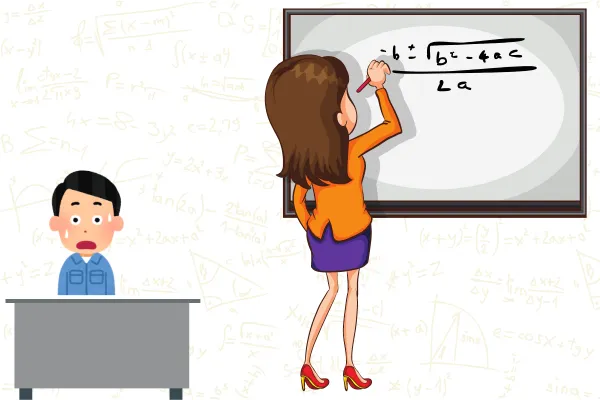Clara James Franchise
FREQUENTLY ASKED QUESTIONS

How Tutors Tailor Maths Lessons
A maths teacher stands at the board explaining something:
”I have a plus here, so I need to subtract this.
Here it says divide so to counteract that, we will multiply.
It says to square here, so we need to square root.
If 10x = 56, that means 1x =”
They turn from the board and ask you for the answer.
Panic. What they have just been explaining makes no sense what-so-ever!
They repeat themselves: “I have a plus here, so I need to subtract this.
Here it says divide so to counteract that, we will multiply.
It says to square here, so we need to square root.
If 10x = 56, that means 1x =
Do you have an answer for me now?”
No, nothing’s changed. A roll of the eyes, a sigh…
“I have a plus here, so I need to subtract this.
Here it says divide so to counteract that, we will multiply.
It says to square here, so we need to square root.
If 10x = 56, that means 1x =”
So, what is the answer?
You feel the embarrassment, but you don’t know. It makes no sense.

Sadly, I think many of us have been in this scenario. For some reason the person explaining it seems to think that by repeating what they have been saying will suddenly make it crystal clear. However, most of the time it just gives the fear more time to wrap itself confidently around you.
The advantage most tutors have over classroom teachers is that they are working in much smaller groups, quite possibly 1-to-1. This means that they can work to the needs of the individual explaining the situation in a way that will make sense to them:
“Imagine I have a set of scales. I need to keep both sides balanced, but my goal is to keep all my ‘x’s and nothing else in this side, and when I finish have nothing but numbers in this side. Ok? So, now I have a +5 in this side. To remove that so I only have x’s on this side I will need to take 5 out from here. Then to keep my scales balanced, I need to take 5 from that side as well. Does that make sense so far?”
A new explanation taken one step at a time. This is so much easier to achieve when you are working in a smaller group and the student/child is less concerned about making a fool of themselves in front of their peers.
But tutoring maths goes deeper than just the explanation.
We all learn differently. However, what is unanimous is that if we just keep relying on worksheets, we are only placing the working out within one place in our brain. We need to offer a variety of resources so that we can cater for different learning styles.
Additionally, many people have a deep fear of the subject, so by making the lesson more interactive we can hopefully encourage the learner to relax and be in a better position to recognise and retain the relevant information.
This might be done by initially creating a bold, colourful mind-map or poster explaining the steps involved with easy-to-follow examples. By using 5 or more colours we are opening more neuropathways making recall more attainable.
Next you might run through a few examples, this might take the form of a worksheet, a code breaker, a game. The games might include a memory game or a game of bingo which requires you to match the corresponding questions and answers, or a board game which will requires you to answer the questions presented as you move around the board.
By offering the information like this you are getting the practice, but at the same time you are helping the child to relax, putting them in a better state of mind to learn.
However, what we need to remember is that every child is an individual.
We need to talk to them and understand how they learn best. I have learned that some children/students will never want to do a worksheet, even with their exams just days away. Others will never want to do anything but worksheets. That is their choice. We are there to guide, to encourage knowledge and hopefully a confidence in the subject.
I am a firm believer that the more we can boost someone’s confidence in a subject, the more willing they will be to have a go. With having a go comes practice and with practice comes confidence. With confidence comes a willingness to have a go. It become a positive spiral of success.
Obviously, every tutor, every child is different, and the lessons will need to reflect that even down to the learning environment that we provide for them: sitting at a desk, laying on our stomachs on the floor, a beanbag or a sofa. Sitting in the garden or at a desk. A tidy desk with minimal distractions, or the reassurance that we have everything we will need to hand with every spread around you.
Work with the child and work with what is best for them. Don’t presume you know their thoughts and answers. Ask them and actively listen to their answers.
If you have any questions or you, or your child is looking for a maths tutor, we can help. Get in touch at [email protected] and we can arrange to have a chat.
What does a Clara James Tutoring Franchise cost?
A franchise has a start up cost of £3,000.
In addition, there is a monthly support fee of £100
What do I receive for my initial fee and monthly franchise fee?
Basically, everything you will need – providing you pass the application process.
Your franchise entitles you to trade under the Clara James Tutoring name and make use of our entire package, systems, and proposition to support you in building a successful business that you will manage and run. Possibly most importantly, 5 days 1-to-1 training including 1 day here in Aylesbury.
What training and support is available?
We’re proud of the training and support that is available to our franchisees It’s as individual as you are!
• You will receive a one-to-one 5-day induction and training.
• Online training courses and webinars,
• and workshops here in Aylesbury, Buckinghamshire.
• Annual 1:1 business review.
• Fortnightly 1:1 mentoring calls.
• Support from head office is just a phone call or email away.
How do I find students?
There are several different ways, but all of this is covered in the intensive 5-day initial training.
What hours will I work?
Your diary is yours to set, but you must be prepared to do some tutoring on an evening or weekend.
If you are interested or have any questions, please do get in touch at

